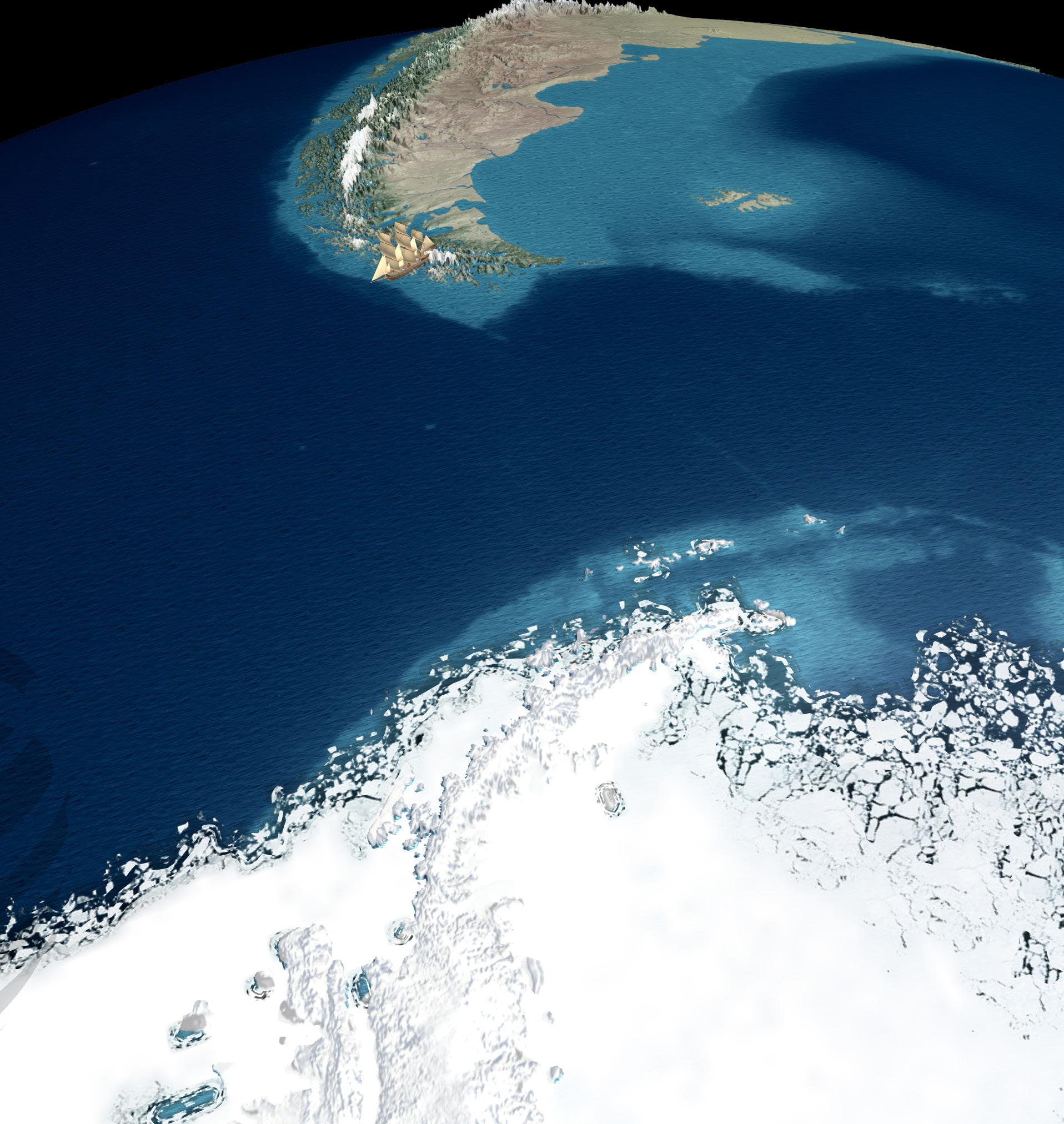

Director’s Overview
ACCESS-NRI is now in its third year of operation. I’m excited to bring you this Highlights Report which outlines our gradual expansion – in terms of our staff, our capability and our achievements. These Highlights reflect our continued engagement with the Australian research community, as well as our first major software releases which are now being announced with increased frequency.
The core of ACCESS-NRI is our modelling framework which includes the full Earth system model and its suite of component models (land, sea ice, atmosphere, ocean, etc). A major component of our work in the last year has been to contribute to the software behind the
development of the next-generation models that will support Australia’s upcoming submission to the Coupled Modelling Intercomparison Project (CMIP). These developments include expanding and updating component models and making sure they can work together within a newly adopted coupling framework. We expect that the first versions of these models will be available to users in 2025. When this occurs, we are planning a series of community engagements that will help us to leverage the broad skills of the Australian research community to evaluate and improve these first releases. Users who are interested in helping with this evaluation should keep their ear to the ground!
Around our core modelling framework is a number of services that allow users to interact with the models. As well as the evaluation workflow mentioned above, we have made huge strides this year in formal releases of our software that provides for reproducibility and provenance. We’ve also held workshops, training days and hackathons to foster community interactions, and are in the process of improving the management of our reference datasets.

ACCESS-NRI has also expanded the remit of its operations, thanks to an additional $9.6M of funding from NCRIS. This funding has allowed us to embark on an ice sheet modelling program (including adoption of the Ice-sheet and Sea-level System Model (ISSM) model), to start a software transformation team (to prepare for upcoming changes in compute hardware and algorithm development) and to initiate a pilot program in community coastal/regional ocean modelling.
Please enjoy reading through the details of these highlights and more in the following pages, and I want to encourage our community of researchers and users to stay engaged with ongoing developments in the next year.
Acknowledgements
We acknowledge the Traditional Owners of the land on which our research infrastructure and community operate across Australia and pay our respects to Elders past and present.
We recognise the thousands of years of accumulated knowledge and deep connection they have with all the Earth systems we simulate.
We would like to thank every organisation, community and individual that makes ACCESS-NRI possible, for their contributions and support.
Our team
People are the most important element of our infrastructure. They include our highly skilled workforce supporting the ACCESS models, data and tools; the climate and weather community, who use and co-develop the ACCESS modelling framework; and members of our Board and Scientific Advisory Committee (SAC), who help govern and advise us.
ACCESS-NRI is committed to being an organisation where people and partnerships thrive and we understand the enormous value of recruiting a diverse workforce. Over the 2023-2024 year, the ACCESS-NRI team grew to a total of 37 staff members. Sadly, we lost one of our members, Jeroen van den Muyzenberg. He will be greatly missed by all the ACCESS-NRI team members

What is ACCESS-NRI?
ACCESS-NRI delivers world-class computer simulations for climate, weather and Earth systems, specifically designed for Australia and the Southern Hemisphere.
Our mission is to build a collaborative national Earth system modelling infrastructure to predict Australia’s weather and climate and support research and decision making in Australia.
We provide open-access and user support to world-class simulations. These simulations are powerful and indispensable tools for researchers, decision makers and policymakers, offering essential insights into diverse areas such as climate change, agriculture, resource management, and disaster response.
Our computational Earth system modelling framework, ACCESS, is hosted at the National Computational Infrastructure (NCI) and enabled by the Australian Government through the National Collaborative Research Infrastructure Strategy (NCRIS) program.
Physics-based simulators for each system
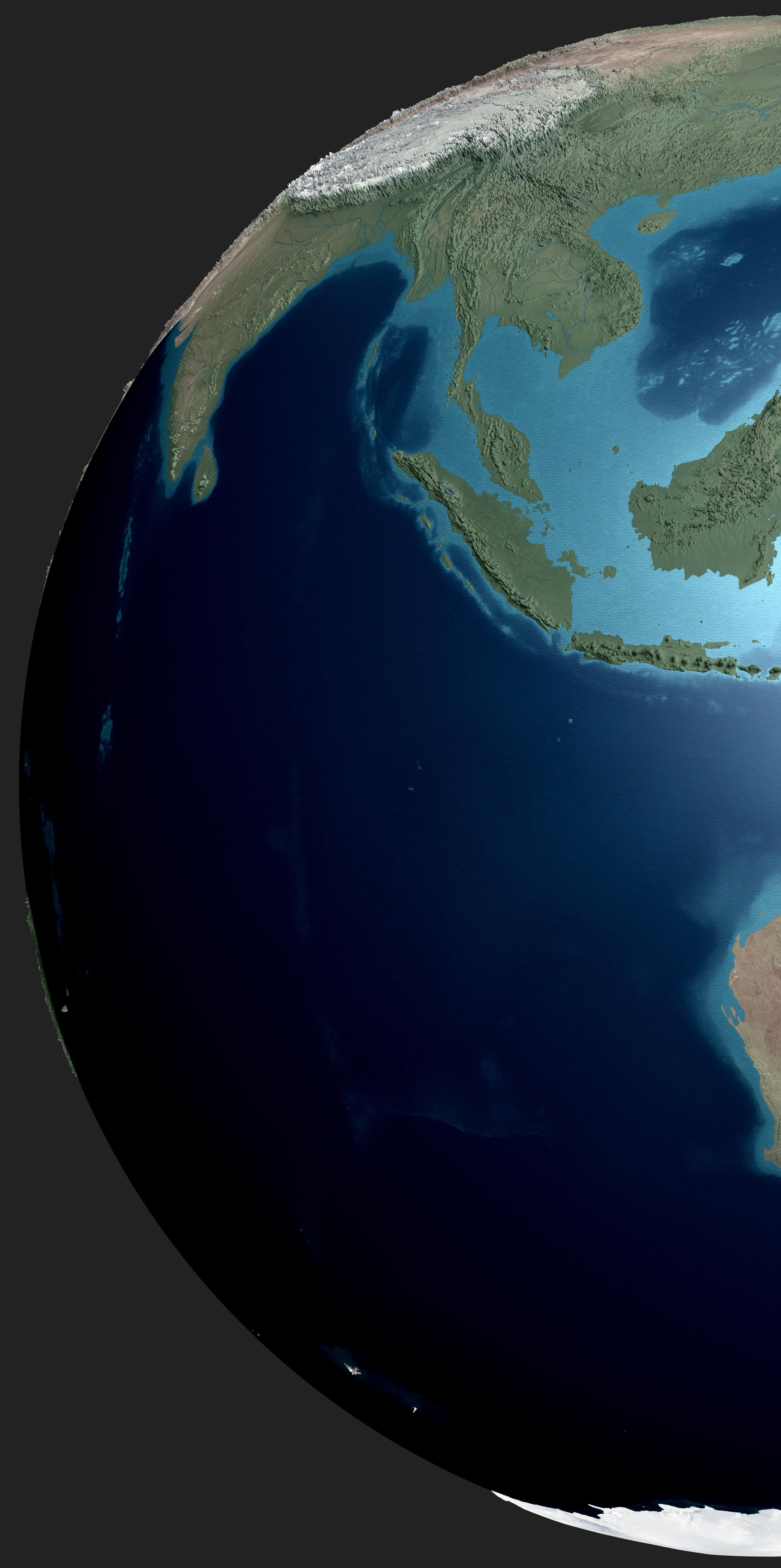
WHAT WE DO
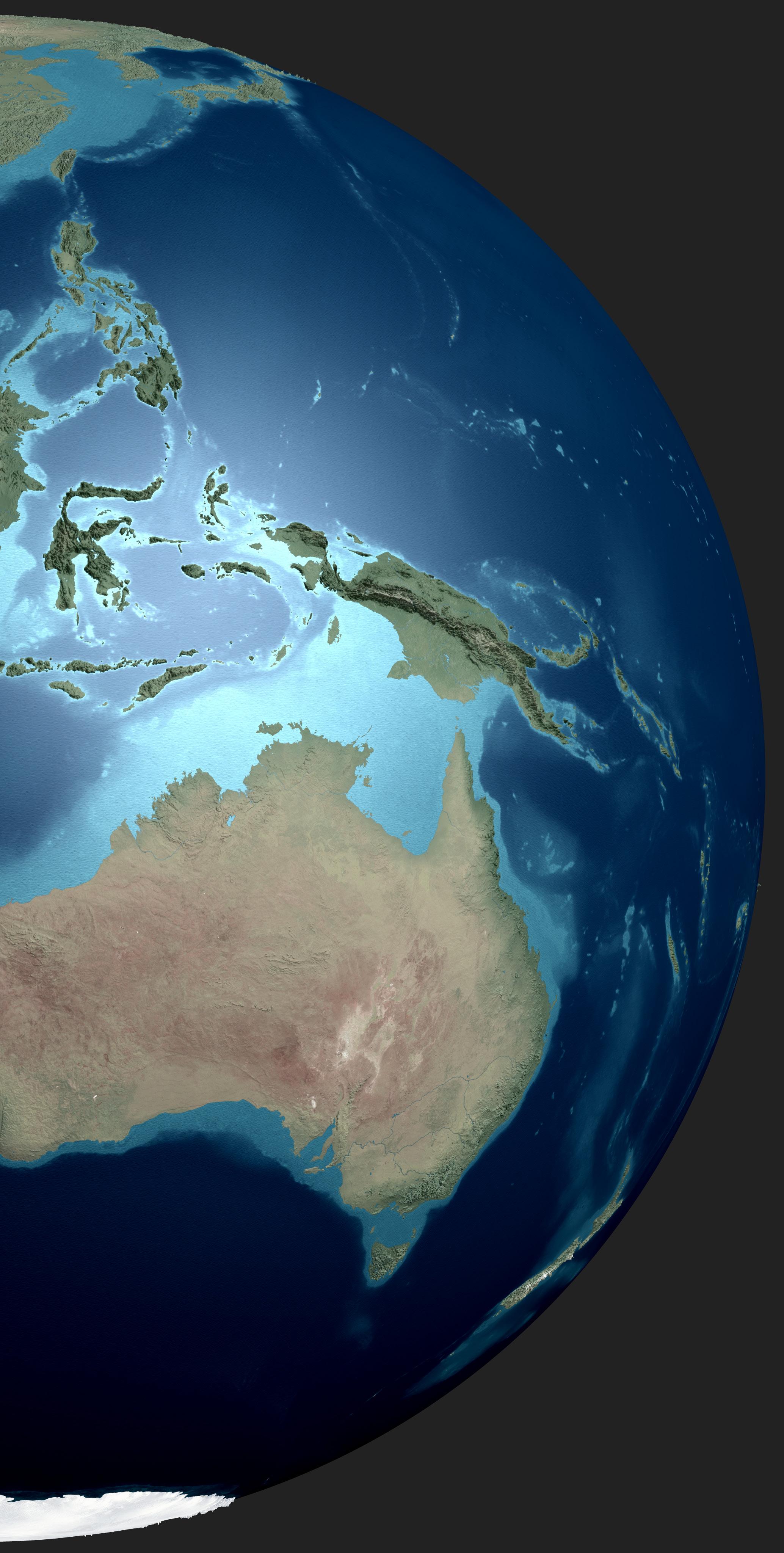
> We work with Australian researchers to maintain the ACCESS model – a framework of open-source climate and weather models using high-performance computers. These models underpin Australia’s climate science capability –and our ability to inform Australia’s climate adaptation strategies.
> We develop the computing software expertise required to keep the ACCESS model running optimally, future-proof it for future computing technologies and make it accessible to all researchers.
> We connect Australia’s climate research communities to collaborate and use the models effectively to generate robust climate simulations for research, policy and decision-making purposes.
> We develop high-quality climate prediction systems essential to Government agencies working to support Australians coping with the increasing effects of climate change and high-impact weather events.
> We deliver a unique Australian and Southern Hemisphere perspective that informs international science and improves the global picture of climate change and its future impacts.
440 contributors
129 Github repositories
~2.3M lines of code
IMPACT WE ENABLE
Building and future-proofing Australia’s sovereign climate research capability essential to support national resilience and wellbeing
Delivering climate simulations specific to Australian and Southern Hemisphere conditions
“The Coupled Model Intercomparison Project (CMIP) is a perfect example that we need the collaboration of multiple national research infrastructures to tackle big challenges like climate change. Without the National Collaborative Research Infrastructure Strategy (NCRIS) that funds crucial national research infrastructure, Australia would have no significant high-performance computing (NCI), no software engineering for climate simulation (ACCESSNRI), no systematic program in ocean observing (IMOS), no program in terrestrial observing (TERN) and no possibility to develop the tools to help Australia build resilience to climate change.”
Understanding how changes to Antarctic ice Southern Ocean currents dynamics affect global systems
Understanding El Niño and La Niña and how these climate systems affect Australia and regional neighbours
Forecasting high-impact weather – wind, bushfire, floods, heatwaves – to inform emergency management
Safeguarding Australia’s future long-term forecasting to inform critical decision making across the government, agriculture, insurance and security sectors
Strengthening global efforts to simulate climate of the past millennium and the future
Reconstructing past climate – understanding how climate changed in the past to inform predictions of future change
Professor Andy Pitman, Director of the ARC Centre of Excellence for Climate Extremes
HIGHLIGHT OF THE YEAR: 2023 ACCESS Community Workshop
Our 2023 ACCESS Community workshop was held in Canberra over 5-6 September 2023 as a hybrid event with the participation of 190 community members, 120 in person and 70 online, with an ACCESS Training Day held the day before and six Community Working Group meetings the day after the Workshop. The event achieved all its aims which included:
> Bring together people across the ACCESS community to present and discuss current and emerging topics (both technical and scientific)
> Provide updates on ACCESS-NRI activities and plans and provide a forum for community feedback
> Support the community Working Groups and foster new and existing community-wide collaborations
> Deliver training on ACCESS-related software, data, and tools
The workshop included 15 science and technical talks, 22 lightning presentations and 50 posters from the ACCESS community as well as 3 invited keynote speakers. The workshop closed with the presentation of the best poster awards. The winners included: Best student poster: Zijin Chen (IMAS/AAPP) 1st place: Yu Wang (AAPP/IMAS/UTAS), 2nd place: Abhik Santra (Monash) and 3rd place: Kial Stewart (ANU).
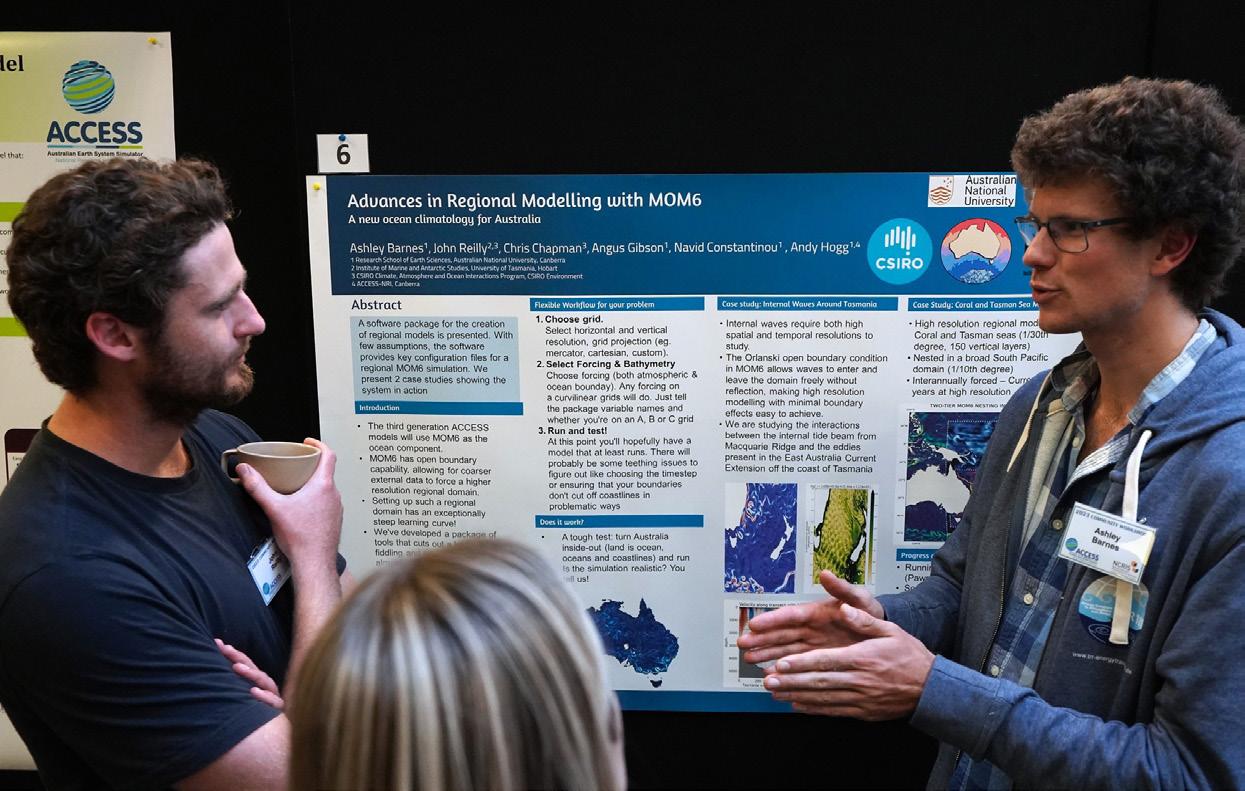

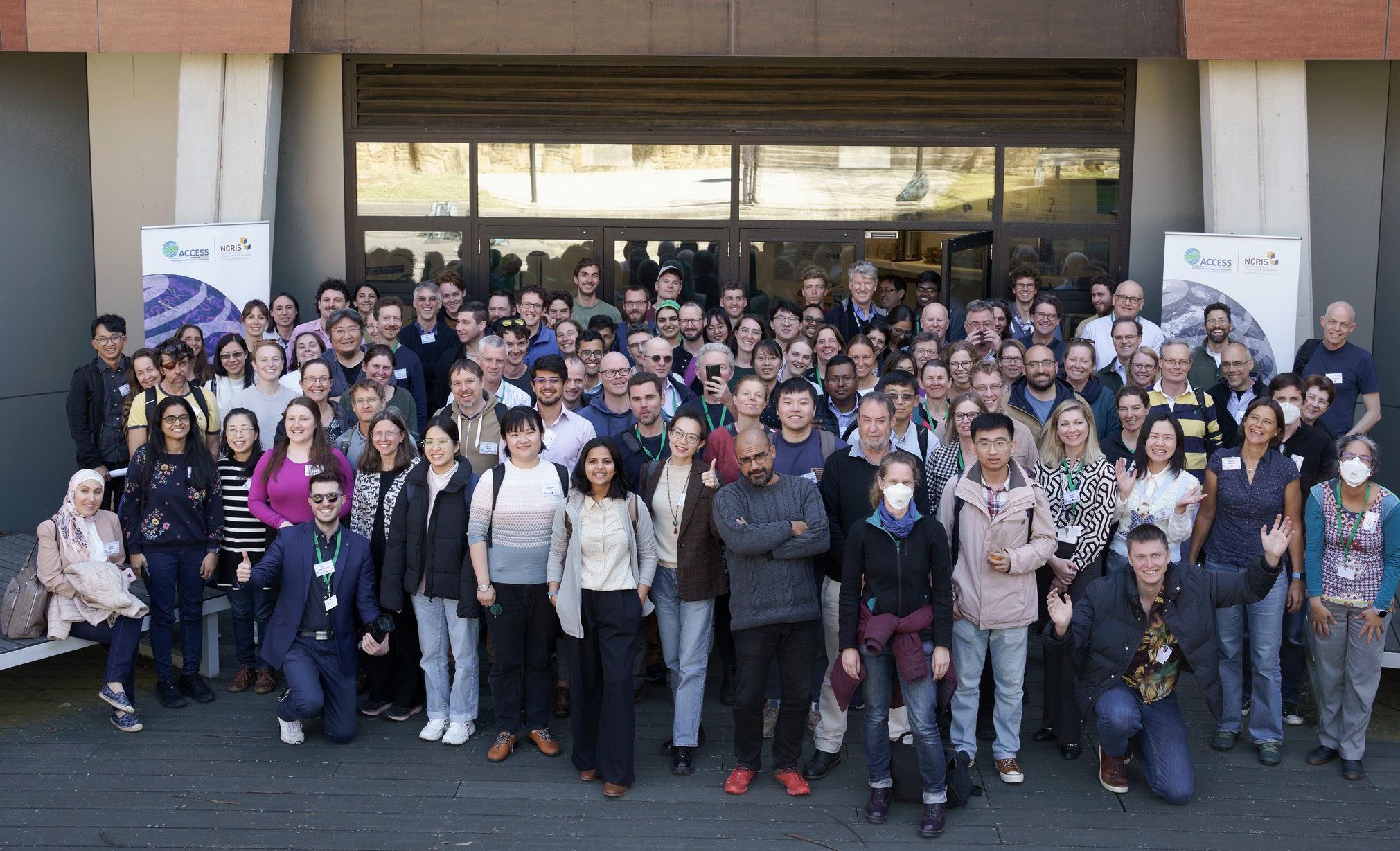
COMMUNITY ENGAGEMENT HIGHLIGHTS
TRAINING HIGHLIGHT: CMIP7 Evaluation Hackathon
The Coupled Model Intercomparison Project (CMIP7) main aim is to better understand past, present and future climate changes arising from natural variability or in response to human activities in a multi-model context. From March 12-14 2024, a group of climate modelers and developers gathered at CSIRO in Aspendale, Victoria for the CMIP7 ACCESS Evaluation Hackathon to evaluate Australia’s climate model ACCESS and provide scientific input for the Coupled Model Intercomparison Project 7 (CMIP7). This hackathon was co-hosted by the Australian Community Climate and Earth System Simulator-National Research Infrastructure (ACCESS-NRI), the ARC Centre of Excellence for Climate Extremes, CSIRO and the National Computational Infrastructure (NCI).
Read or download the report here

Including land ice in the ACCESS Earth System Model: a community-led model selection approach
ACCESS-NRI has adopted the Ice-sheet and Sealevel System Model (ISSM) as its support Ice Sheet model after an open and rigorous community-led selection process.
The ACCESS Cryosphere Modelling Community Working Group went through a 9-month process to develop an open, transparent, and rigorous selection approach over three phases: community consultation, assessment and model selection.
ACCESS-NRI received funding from the 2023 NCRIS round to support ice sheet and coastal ocean modelling as part of an NCRIS-wide Coastal Research Infrastructure (CoastRI) Initiative.
ACCESS-NRI will implement ISSM configurations of Antarctica and Greenland, with the ultimate goal to couple ISSM into ACCESS in order to improve decadal- to centennial-scale projections of global mean and regional sea level and climate change.
“The cryosphere community worked together to assess a large number of existing ice sheet models and select an ice sheet model for ACCESS. This is incredibly important given that we’re a relatively small community and this decision will impact us all. Our whole process was open and is documented at the ACCESS-Hive Forum”.
Dr Felicity
McCormack Chief Investigator
on the ARC Special Research Initiative Securing Antarctica’s Environmental Future and co-leader of the selection process.
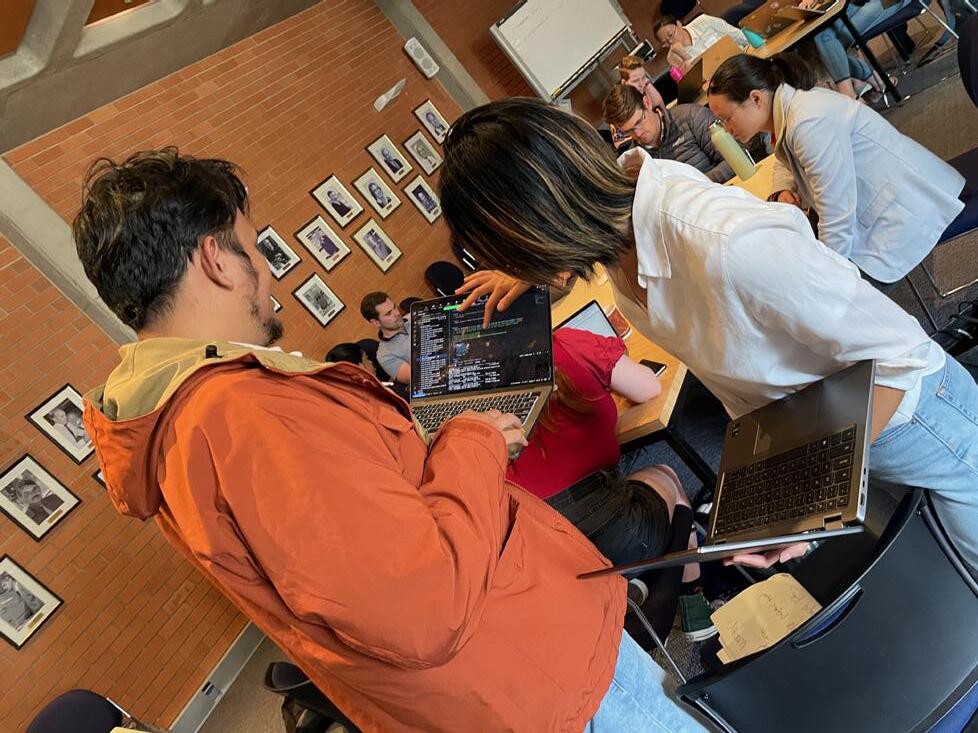

“The inclusion of an ice sheet model in ACCESS is a pivotal change to Australia’s earth system modelling, and a step change for sea-level research. The fate of Antarctica and Greenland could cost Australian trillions in terms of lost economic growth by 2100. The risks are large, and the uncertainty is deep.”
Dr. Nathan Bindoff, ARC Laureate Fellow and Program Leader of the Australian Antarctic Program Partnership (AAPP)


User Support
In August 2023, ACCESS-NRI released the User Support; a new way for ACCESS users to get help for the software infrastructure (models, configurations and tools) that is supported by ACCESS-NRI.
Our User Support approach curates questions and their answers to build a knowledge base of climate and weather modelling science in Australia. User support is provided through existing ACCESS-Hive Forum, which is the place for the community to assist one another.
More information.

Merit Allocation Scheme
In November 2023, ACCESS-NRI launched the Merit Allocation Scheme to support access to high-performance computing (HPC) and storage resources at the National Computational Infrastructure (NCI) for the ACCESS community. This scheme was enabled through the NCRIS 2023 Funding round. The allocation resources are coordinated and prioritised through the ACCESS Community Working Groups, with oversight by the Scientific Advisory Committee. The assessment criteria and available resources can be found our website.
More information.
405 ACCESS users
5,615 ACCESS-Hive forum posts
983 pull requests
RELEASE HIGHLIGHTS
ACCESS-NRI releases two model evaluation workflows for the ESMValTool and ILAMB tools
Model evaluation tools allow researchers to compare and evaluate different Earth-system models, which is essential to test their accuracy and understand how they compare against other models and with available observations.
In November 2023, The ACCESS-NRI Model Evaluation and Diagnostics (MED) team released two new workflows for the Earth System Model Evaluation Tool (ESMValTool) and the International Land Benchmarking (ILAMB) tools.
ESMValTool and ILAMB are developed by an international community of researchers and research software engineers. ACCESS-NRI is joining those efforts and releasing configurations and workflows for those tools to be used by the ACCESS community at the National Computational Infrastructure (NCI).
The ACCESS Land Surface model (CABLE) has moved to GitHub
Modelling soils and vegetation is a critical element to simulate our climate and weather. This is known as land surface modelling. ACCESS has a specific land surface model called Community Atmosphere Biosphere Land Exchange (CABLE), developed with Australian land uniqueness in mind.
The ACCESS land surface model (CABLE) code is now hosted on the GitHub platform. GitHub integration is an important step in making the code more open and discoverable, and allows it to use the new ACCESS-NRI integration and deployment software pipeline.
“The change of hosting platform to git/GitHub brings a range of benefits. Firstly, it aligns with our goal of Open Science by hosting CABLE publicly and improving its discoverability. Additionally, GitHub provides integrations and services to simplify the code management and collaborative development,” says Dr Claire Carouge, Team leader of the Land Surface Modelling Team.





“The support from ACCESS-NRI means that we can dramatically increase the scope of things we can attempt to do and the rate at which we can achieve them”
Dr Andrew Kiss (ANU), user and co-developer of the ACCESS-OM2 Ocean model
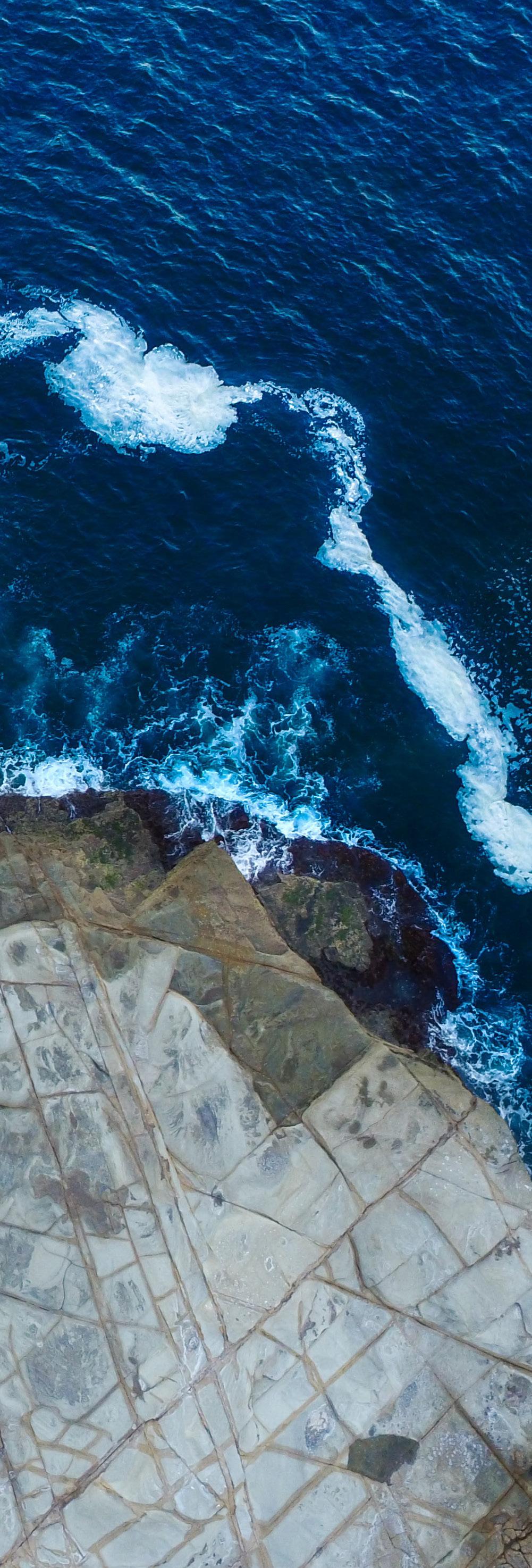
Modernising climate modelling software: ACCESS-NRI new software pipeline
Modernising climate modelling software directly impacts how we understand and respond to climate change. Computer models are the climate scientist’s equivalent of laboratory experiments, allowing researchers to explore the intricate dynamics of our planet’s climate.
To increase researchers’ trust in their predictions, ACCESS-NRI is introducing a new software pipeline to ensure models work, are error-free and can be easily found and used by researchers.
This new software pipeline makes it easier to update and manage the complex software that powers Australia’s climate model, ACCESS. This will improve global and local predictions about climate and weather events such as El Niño, bushfires, floods or the melting of Antarctica.
In May 2024, ACCESS-NRI completed its first fully supported model release: the ACCESS-OM2 Ocean and Sea-Ice Model. This release uses the new ACCESS-NRI’s software pipeline and best practices.
ACCESS-NRI will apply this new software integration and deployment pipeline to all the models released in the future, including the new version of the ocean and sea-ice model ACCESS-OM3.
CESS-NR I IN NUMBERS
4 datasets 5 models and configurations
7 tools 3 visualisations
PUBLIC ENGAGEMENT HIGHLIGHTS
Visualising Earth Systems
Visualisations of Earth system models are powerful engagement tools for our infrastructure helping researchers convey the narrative behind their findings and connect with a broader audience. In the case of Antarctica, understanding and explaining its role as a life support system for Earth to the public has never been more critical, as researchers need to communicate this urgency clearly to decision makers, government and the public.
This year, we released our first two visualisations about the loss of Antarctica’s ice, produced in collaboration with Dr Ed Doddridge. from the Australian Antarctic Partnership Program (AAPP) and Owen Kaluza from ACCESS-NRI. These visualisations were used to produce two short videos in collaboration with AAPP and the Terrestrial Ecosystem Research Network (TERN), narrated by Ed Doddridge. These videos allow us to look into Antarctica 120 years ago and compare it with Antarctica today. An insightful view of the importance of Antarctica and about how alarming the loss of sea-ice is for the whole planet.
Watch the videos

Meet and greet the ACCESS-NRI team event
Engaging with the ACCESS Community is essential to our mission of improving the models and making them easy to use to tackle the biggest challenge of our times: climate change. ACCESS-NRI organised a “Meet and Greet the team event” on the 5 February at ANU at the end of the Workshop day of the Australian Meteorological and Oceanographic Society (AMOS) Conference 2024, attended by around 110 people. ACCESS-NRI Director Andy Hogg opened the event with a short intro about what ACCESS is and how it supports researchers and policy makers, followed by short presentations by each of the ACCESS-NRI team leads.
ACCESS-NRI at Science Meets Parliament
Last March, Science Meets Parliament (SMP), organised by Science and Technology Australia (STA) took place in Canberra. This annual twoday event aims to forge deeper connections between those working in STEM (Science, Technology, Engineering and Mathematics) and the nation’s key decision and policy makers. Over 360 delegates and more than 90 parliamentarians participated in the event, including three representatives from ACCESS-NRI who met with federal Parliamentarians to share and promote the work of the ACCESS National Research Infrastructure.


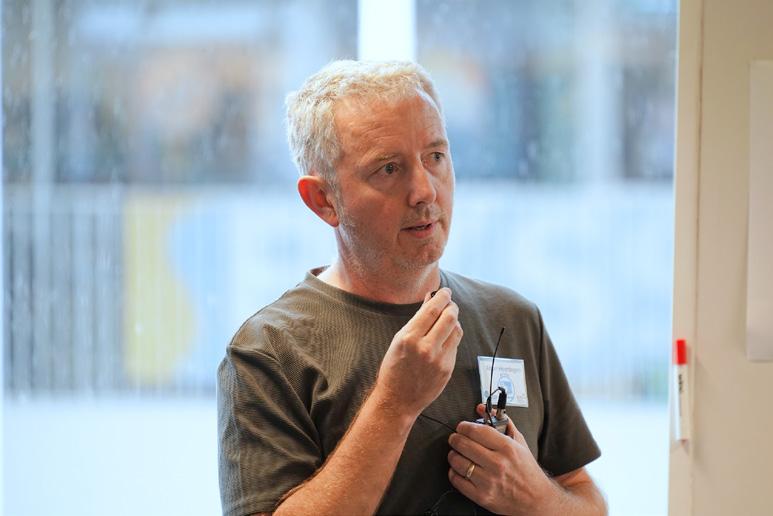

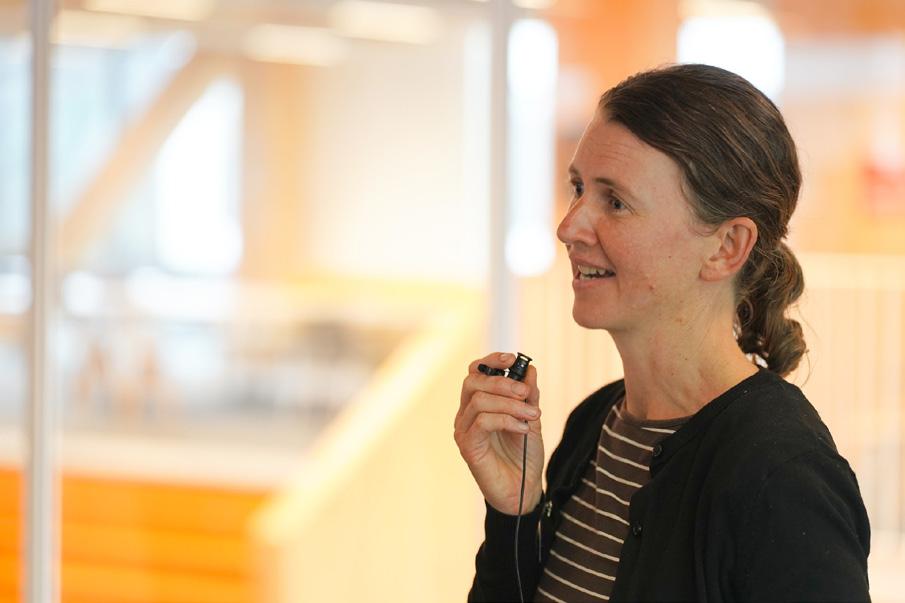
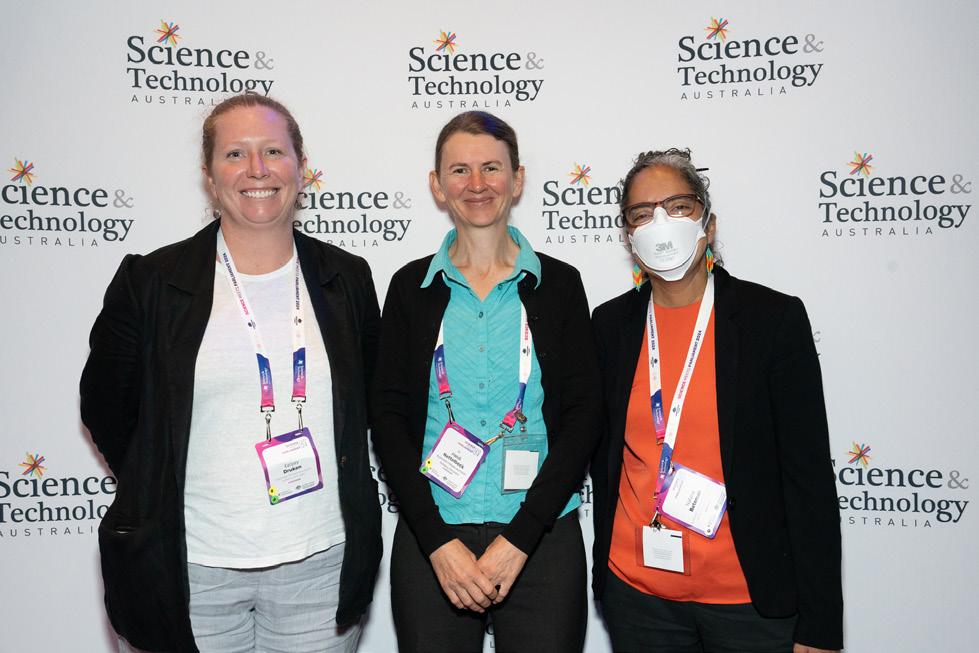
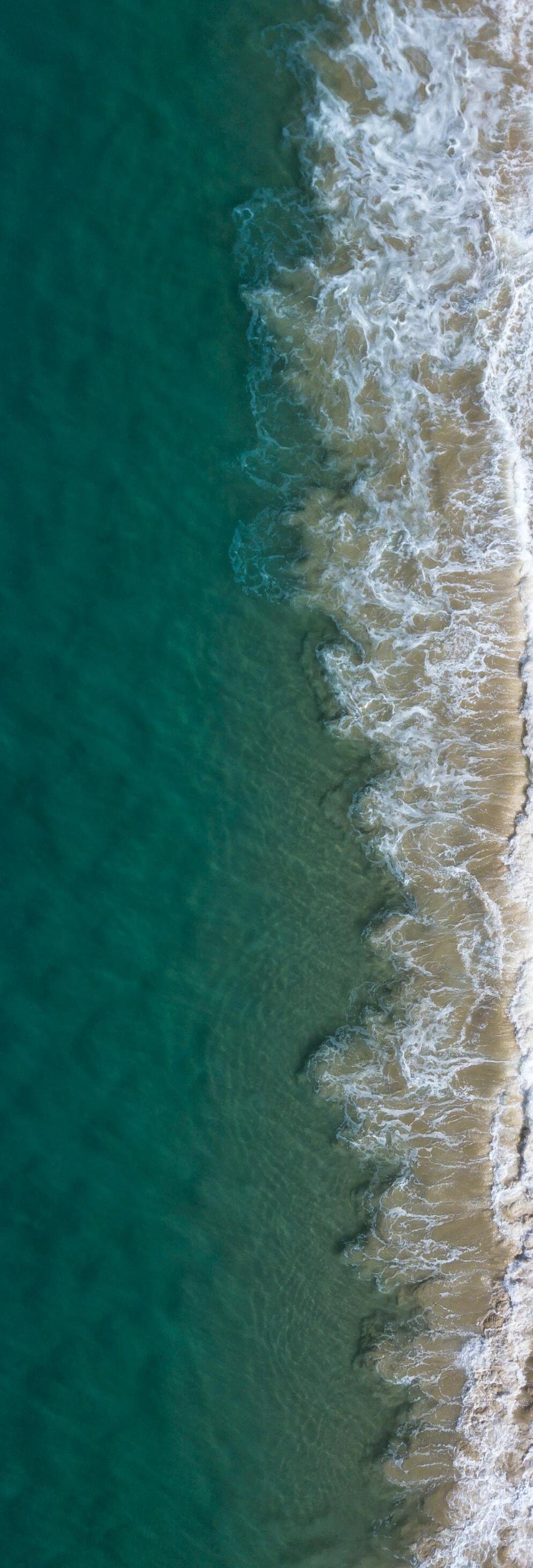

NCRIS COLLABORATIONS
ENGAGEMENT HIGHLIGHTS
2023 NCRIS Funding Round for ACCESS modelling
In October 2023 the Department of The Department of Education, through the National Collaborative Research Infrastructure Strategy (NCRIS) announced the results of their 2023 NCRIS Funding Round. ACCESS-NRI received $9,642,54 over the next 4 years – which will include compute and storage and funding in areas like ice sheet modelling, land modelling and evaluation, Coupled Model Intercomparison Project phase 7 (CMIP7) development and software transformation.
Enabling research and innovation to address climate change through trust and identity
The Australian Access Federation (AAF) and ACCESS-NRI are partnering through the Trust and Identity Pathfinder program, funded by the Australian Government’s National Collaborative Research Infrastructure Strategy (NCRIS), to explore the challenges of reporting on the usage of ACCESS-NRI assets such as code and data.
NCRIS at e-research Australasia 2023
ACCESS-NRI participated as an exhibitor and presenter in the e-research Australasia 2023 Conference in Brisbane joining other research capabilities around the country, including several National Research Infrastructures. Aidan Heerdegen presented on RRR: Reliability, Reproducibility and Replicability in Climate Modelling and Romain Beucher on Building an Australian community framework for Evaluation of Earth System Models.
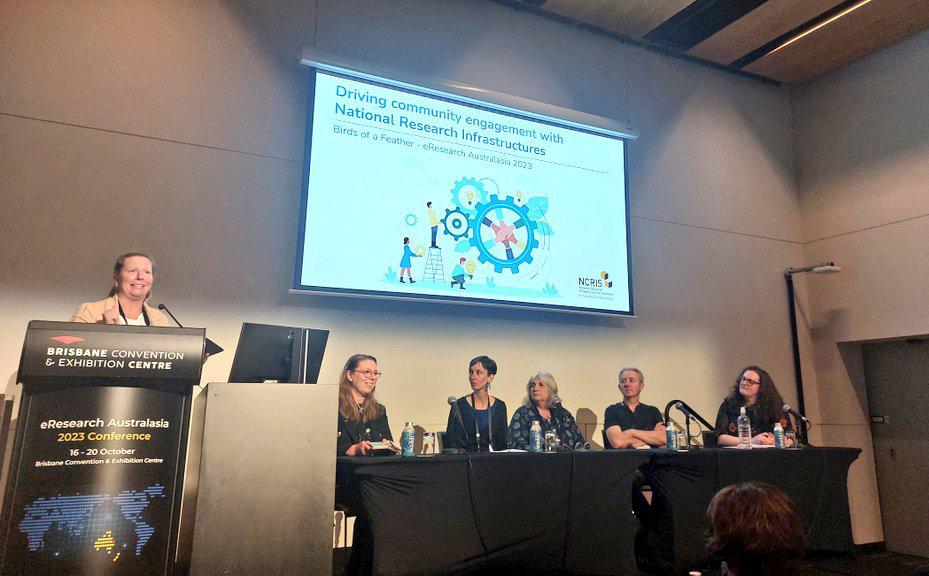
ACCESS-NRI organised and participated in the Birds of Feather session: Driving community engagement with National Research Infrastructures on community engagement in collaboration with the Australian Access Federation (AAF), Australian BioCommons, ARDC and AURIN.
Integrated Earth 2023 Conference Highlights
Members of the Earth science community from all over Australia, met in Canberra in September 2023 to take part in a unique gathering – the Integrated Earth 2023 symposium, which brought together researchers from the five broad spheres of Earth science: the geosphere, cryosphere, hydrosphere, biosphere and atmosphere. Organised by AuScope, TERN, NCI, ACCESS-NRI, ARDC and IMOS – a partnership of infrastructure facilities funded by the Australian Government’s National Collaborative Research Infrastructure Strategy (NCRIS) – Integrated Earth created an environment to discuss the future directions of Earth science in Australia.
website views
AUG 2023 Launch of the ACCESS Support
Planning our Work
SEP 2023 ACCESS Community Workshop 2023
OCT 2023 NCRIS additional funding awarded for ACCESS modelling
ACCESS-NRI releases two model evaluation workflows for the ESMValTool and ILAMB tools
Launch of the ACCESS-NRI Merit Allocation scheme
DEC 2023
ACCESS-NRI Work plan (2023-2024) released
Meet and greet the ACCESS-NRI team event at AMOS
In 2023, ACCESS-NRI released the 2023-2024 Annual Work Plan, as a result of our internal strategy meeting and Staff retreat. This plan is a document designed to show what ACCESS-NRI is working on that year and how it may benefit the ACCESS community.
Read or download
ACCESS-NRI Workplan 2023-2024
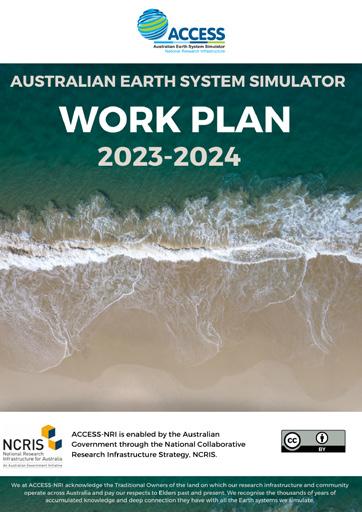

Next year’s Work Plan (2024-2025) has been released and you can access it here:
ACCESS-NRI Workplan 2024-2025

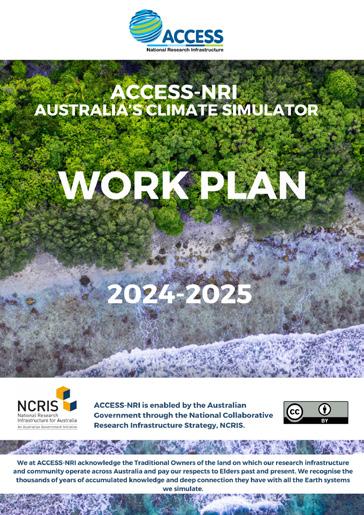
First ACCESS-NRI visualisation released (Antarctica)
New ACCESS pipeline released
New Team leads for the User Training team and Software Transformation teams
ACCESS Land Model, Cable moves to GitHub
Recruiting: August 2023 to June 2024
Credits
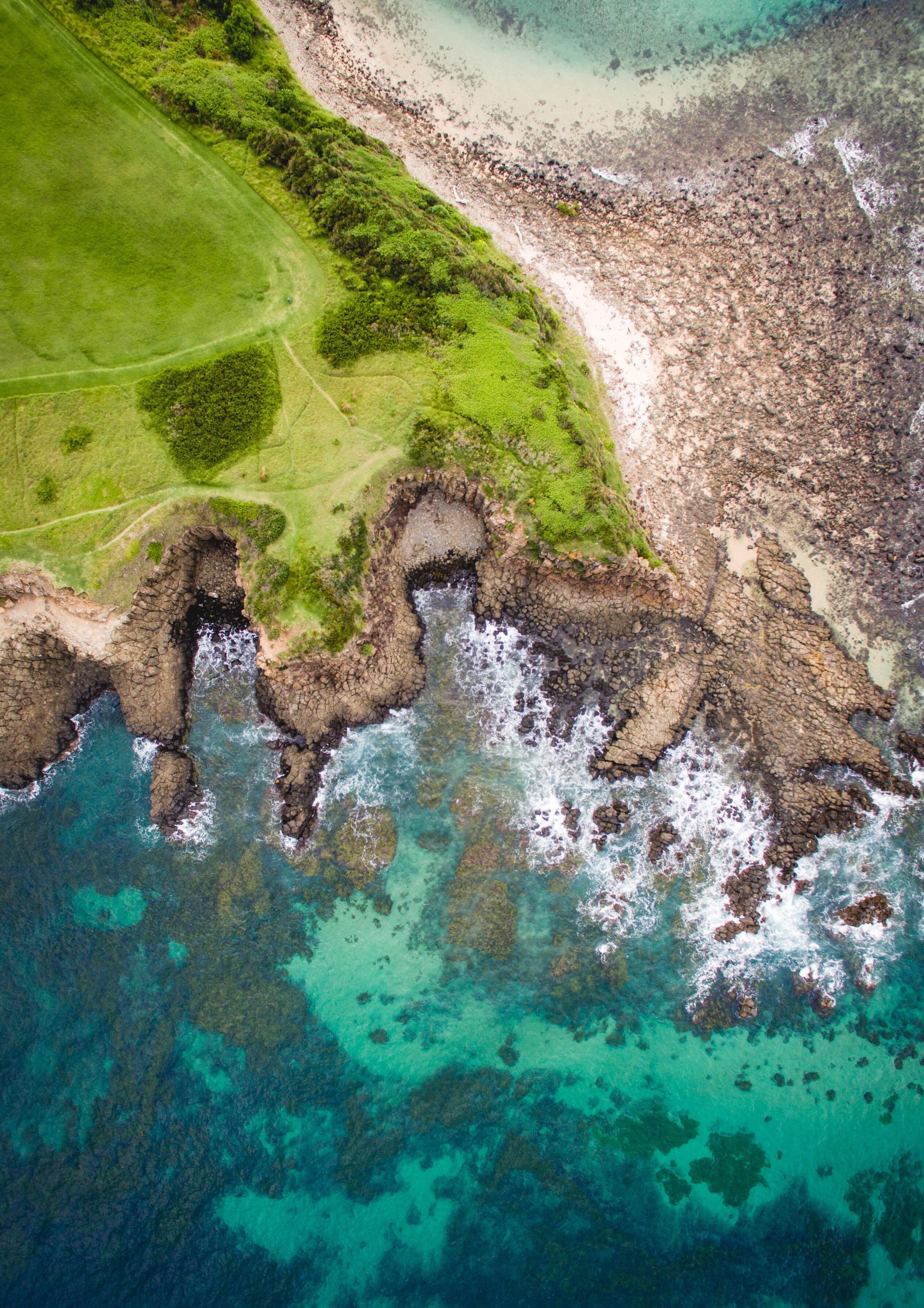
Editors: Natalia Bateman, Andy Hogg, Kelsey Druken, Victoria Allen
ACCESS-NRI
Designer: Carl Davies
CMDphotographics
Citing this publication
ACCESS-NRI, Australia’s climate simulator. (2024). ACCESS-NRI 2023-2024 Highlights Report Zenodo. https://doi.org/ 10.5281/zenodo.13751188
DOI: https://doi.org/10.5281/zenodo.13751188

With the exception of the NCRIS and partner logos, or where otherwise noted, this document is licensed under the Creative Commons Attribution 4.0 International licence
To receive news and updates from ACCESSNRI subscribe to our ACCESStory newsletter: More information:
www.access-nri.org.au
E-mail: access.nri@anu.edu.au

Image credits:
Front and back cover: Owen Kaluza, ACCESS-NRI
Inner front cover, page 7: Adam Huttner-Koros, NCI
Page 1, 5, 6, 10: Harshula Jayasuriya, ACCESS-NRI
Page 6 (Background): David Clode, Unsplash
Page 8 (Background): Joshy, Unsplash
Page 10 (Background): Graham Holtsh, Unsplash
Page 6, 10 (Antarctica images): Owen Kaluza, ACCESS-NRI
Page 8-9 (Earth): Adele Morrison, ANU
Page 8: Bureau of Meteorology and NCI
Page 13 (Background): Ralph Howald, Unsplash
Model credits:
Page 2-3: More information

Australia’s Climate Simulator
ACCESS-NRI is enabled by the Australian Government through the National Collaborative Research Infrastructure Strategy (NCRIS), a program managed by the Department of Education. 2023-2024
Our founding partners: Highlights Report

